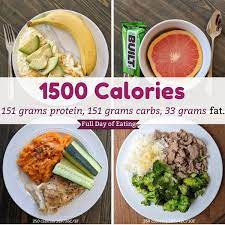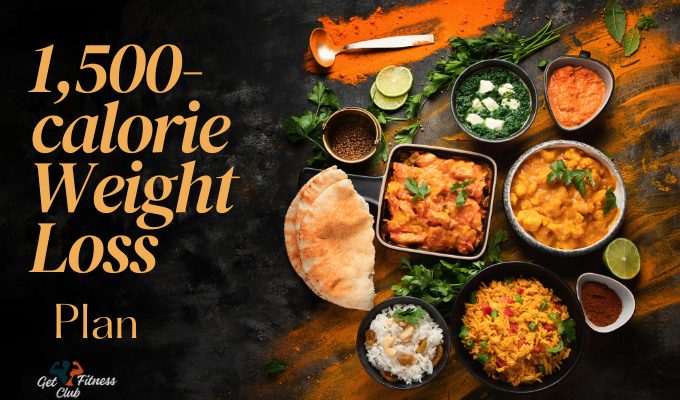Achieve Goals with Our 1,500-calorie Weight Loss Plan:
Are you embarking on a journey to shed those extra pounds? Welcome to the game-changer 1,500-calorie Weight Loss Plan. Picture this: a roadmap that guides you towards a healthier, fitter without leaving you famished. It’s not just about counting calories; it’s about making every calorie count. This strategic plan balances nutrition and flavor, making weight loss achievable and enjoyable. Bid farewell to crash diets and embrace a sustainable lifestyle. Join us as we unravel the simplicity and effectiveness of the 1,500-calorie Weight Loss Plan, your ally in the quest for a slimmer, healthier you. Let the transformation begin!

1,500-calorie Weight Loss Plan
1,500-calorie Diet Plan for Weight Loss
How to Meal Prep Your Week of Meals:
Planning and preparing your meals in advance is a key aspect of successful weight loss. Follow this1,500-calorie Weight Loss Plan to help you achieve your weight loss goals while maintaining a balanced and nutritious intake.
Day 1:
Breakfast (387 calories)
Get your metabolism going with a nutrient-dense breakfast. Opt for a bowl of oatmeal topped with berries and a sprinkle of chia seeds.
A.M. Snack (190 calories)
Keep your energy levels stable with a mid-morning snack. Consider a small apple paired with a tablespoon of almond butter.
Lunch (325 calories)
Enjoy a grilled chicken salad with a variety of colorful vegetables for lunch. Use a light vinaigrette dressing for added flavor.
P.M. Snack (105 calories)
Satisfy your afternoon cravings with a handful of baby carrots and hummus. This combination provides fiber and protein to keep you full.
Dinner (451 calories)
Dinner can consist of baked salmon with quinoa and steamed broccoli. This combination is rich in omega-3 fatty acids, protein, and essential nutrients.
Day 2:
Breakfast (387 calories)
Repeat the satisfying oatmeal breakfast from Day 1.
A.M. Snack (192 calories)
Opt for a medium-sized banana and a handful of mixed nuts for a tasty and filling snack.
Lunch (344 calories)
Enjoy a turkey and avocado wrap with whole-grain tortillas. Add plenty of vegetables for extra fiber.
P.M. Snack (95 calories)
For a light afternoon snack, try a cup of Greek yogurt with a drizzle of honey.
Dinner (495 calories)
Grilled shrimp with quinoa and roasted vegetables make for a delicious, low-calorie dinner option.
Day 3:
Breakfast (387 calories)
Stick to the oatmeal routine for a consistent and satisfying start to your day.
A.M. Snack (95 calories)
Have a small serving of fresh berries for a refreshing morning snack.
Lunch (344 calories)
A vegetable stir-fry with tofu and brown rice provides a nutritious and fulfilling lunch option.
P.M. Snack (201 calories)
Snack on a handful of edamame for a protein-rich and flavorful afternoon treat.
Dinner (475 calories)
Baked chicken breast with sweet potato and green beans offers a well-balanced and tasty dinner choice.
Day 4:
Breakfast (393 calories)
Try a breakfast burrito with scrambled eggs, black beans, and salsa wrapped in a whole-grain tortilla.
A.M. Snack (78 calories)
Keep it light with a small pear or apple.
Lunch (344 calories)
A tuna salad with mixed greens and cherry tomatoes is a light yet satisfying lunch option.
P.M. Snack (188 calories)
Munch on a handful of pretzels with hummus for a crunchy and flavorful snack.
Dinner (521 calories)
Grilled steak with quinoa and roasted Brussels sprouts is a hearty and nutrient-dense dinner choice.
Day 5:
Breakfast (287 calories)
Switch things up with a Greek yogurt parfait layered with granola and fresh berries.
A.M. Snack (192 calories)
Opt for a medium-sized apple and a tablespoon of peanut butter for a satisfying snack.
Lunch (344 calories)
A whole-grain wrap with grilled vegetables and feta cheese makes for a flavorful and filling lunch.
P.M. Snack (210 calories)
A small handful of almonds and a piece of dark chocolate can curb your afternoon cravings.
Dinner (454 calories)
Salmon with quinoa and asparagus is a light and nutritious dinner option.
Day 6:
Breakfast (393 calories)
Enjoy a vegetable omelet with whole-grain toast for a protein-packed breakfast.
A.M. Snack (200 calories)
Indulge in a small smoothie made with spinach, banana, and almond milk.
Lunch (360 calories)
Chicken Caesar salad with a light dressing is a classic and satisfying lunch choice.
P.M. Snack (78 calories)
Keep it simple with a handful of cherry tomatoes.
Dinner (465 calories)
Baked cod with brown rice and steamed broccoli offers a flavorful and low-calorie dinner.
Day 7:
Breakfast (285 calories)
Start your day with a fruit and yogurt smoothie for a refreshing and nutrient-dense breakfast.
A.M. Snack (95 calories)
Snack on a small orange or a handful of grapes for a burst of natural sweetness.
Lunch (345 calories)
A quinoa and black bean bowl with avocado is a filling and wholesome lunch option.
P.M. Snack (220 calories)
Satisfy your sweet tooth with a small serving of mixed berries and a dollop of whipped cream.
Dinner (556 calories)
Grilled vegetable and chickpea curry with brown rice is a flavorful and satisfying dinner choice

Conclusion:
In summary, the 1,500-calorie Weight Loss Plan provides a balanced and adaptable approach. By focusing on nutrient-dense foods and incorporating regular exercise, individuals can achieve gradual and sustainable weight loss. The plan’s versatility allows customization based on dietary preferences, promoting a positive relationship with food. However, it’s crucial to consult with healthcare professionals for personalized adjustments, considering factors like age, gender, and health conditions. Ultimately, the 1,500-calorie diet serves as a realistic and achievable strategy for fostering a healthier lifestyle and achieving long-term weight management.
FAQS:
Q1:How much weight will I lose in 1500 calories a day?
The amount of weight you’ll lose on a 1500-calorie-per-day diet depends on various factors, including your current weight, metabolism, activity level, and overall health. Generally, a daily caloric deficit (burning more calories than you consume) of about 500 calories can lead to a sustainable weight loss of about 1 pound per week. However, individual results may vary.
Q2:What should I eat for 1500 calories a day?
To maximize the effectiveness of a 1500-calorie diet, it’s important to choose nutrient-dense foods that provide essential vitamins, minerals, and macronutrients. Make sure you eat a balanced diet that includes lean proteins, whole grains, fruits, vegetables, and healthy fats.. Portion control is crucial to ensure you stay within the calorie limit.
Q3:Is 1500 calories enough to lose belly fat?
While a 1500-calorie diet can contribute to overall weight loss, it may not specifically target belly fat. Spot reduction is challenging, and overall fat loss is achieved through a combination of a balanced diet, regular exercise, and a healthy lifestyle.
Q4:How to lose 1,500 calories per day?
To lose 1500 calories per day through exercise, you can engage in a mix of cardiovascular activities like running, cycling, or swimming, along with strength training. The exact duration and intensity of your workouts will depend on factors such as your fitness level and preferences.
